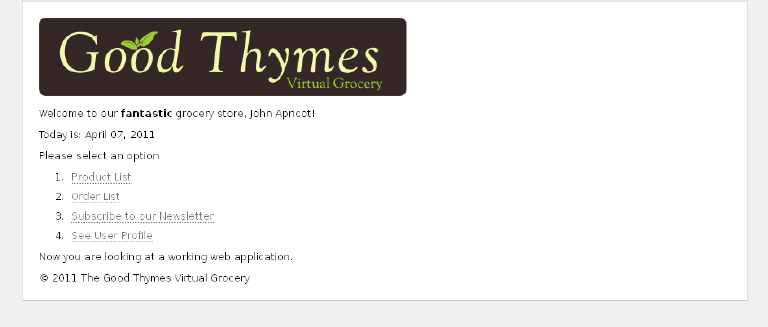示例所示的源代码和本指南中未来的章节都可以在此找到Good Thymes Virtual Grocery GitHub repository.
一个购物网站
为了更好地解释Thymeleaf参与处理模板的概念,本教程将使用一个演示的应用程序,您可以从上面地址下载项目。
这个应用程序是一个虚构的虚拟商店网站,并将为我们提供足够的场景举例说明不同Thymeleaf特性。
我们需要为我们的应用程序设计一套非常简单的实体模型: Products(商品) 通过创建orders(订单)卖给Customers(客户)。我们也管理这些产品的Comments(评论)。应用程序模型如下:

我们的小应用程序也将有一个非常简单的服务层,服务对象包含方法如下:
public class ProductService {
...
public List<Product> findAll() {
return ProductRepository.getInstance().findAll();
}
public Product findById(Integer id) {
return ProductRepository.getInstance().findById(id);
}
}
最后,在web层有一个过滤器,将根据请求URL委托执行Thymeleaf-enabled命令:
private boolean process(HttpServletRequest request, HttpServletResponse response)
throws ServletException {
try {
/*
* Query controller/URL mapping and obtain the controller
* that will process the request. If no controller is available,
* return false and let other filters/servlets process the request.
*/
IGTVGController controller = GTVGApplication.resolveControllerForRequest(request);
if (controller == null) {
return false;
}
/*
* Obtain the TemplateEngine instance.
*/
TemplateEngine templateEngine = GTVGApplication.getTemplateEngine();
/*
* Write the response headers
*/
response.setContentType("text/html;charset=UTF-8");
response.setHeader("Pragma", "no-cache");
response.setHeader("Cache-Control", "no-cache");
response.setDateHeader("Expires", 0);
/*
* Execute the controller and process view template,
* writing the results to the response writer.
*/
controller.process(request, response, this.servletContext, templateEngine);
return true;
} catch (Exception e) {
throw new ServletException(e);
}
}
- 1
- 2
- 3
- 4
- 5
- 6
- 7
- 8
- 9
- 10
- 11
- 12
- 13
- 14
- 15
- 16
- 17
- 18
- 19
- 20
- 21
- 22
- 23
- 24
- 25
- 26
- 27
- 28
- 29
- 30
- 31
- 32
- 33
这是我们的 IGTVGController 接口:
public interface IGTVGController {
public void process(HttpServletRequest request, HttpServletResponse response,ServletContext servletContext, TemplateEngine templateEngine);
}
现在我们要做的就是创建IGTVGController接口的实现,从服务层获取数据并使用TemplateEngine对象处理模板。最后,它会像这样:

但首先让我们看看模板引擎是如何初始化的。
建立和配置模板引擎
在我们的过滤器的process(…)方法包含这个句子:
TemplateEngine templateEngine = GTVGApplication.getTemplateEngine();
这意味着GTVGApplication类负责创建和配置程序中最重要的一个对象TemplateEngine实例。我们的org.thymeleaf.TemplateEngine对象初始化过程如下:
public class GTVGApplication {
...
private TemplateEngine templateEngine;
...
public GTVGApplication(final ServletContext servletContext) {
super();
ServletContextTemplateResolver templateResolver = new ServletContextTemplateResolver(servletContext);
// HTML is the default mode, but we will set it anyway for better understanding of code
templateResolver.setTemplateMode(TemplateMode.HTML);
// This will convert "home" to "/WEB-INF/templates/home.html"
templateResolver.setPrefix("/WEB-INF/templates/");
templateResolver.setSuffix(".html");
// Set template cache TTL to 1 hour. If not set, entries would live in cache until expelled by LRU
templateResolver.setCacheTTLMs(Long.valueOf(3600000L));
// Cache is set to true by default. Set to false if you want templates to
// be automatically updated when modified.
templateResolver.setCacheable(true);
this.templateEngine = new TemplateEngine();
this.templateEngine.setTemplateResolver(templateResolver);
this.controllersByURL = new HashMap<String, IGTVGController>();
this.controllersByURL.put("/", new HomeController());
this.controllersByURL.put("/product/list", new ProductListController());
this.controllersByURL.put("/product/comments", new ProductCommentsController());
this.controllersByURL.put("/order/list", new OrderListController());
this.controllersByURL.put("/order/details", new OrderDetailsController());
this.controllersByURL.put("/subscribe", new SubscribeController());
this.controllersByURL.put("/userprofile", new UserProfileController());
}
...
}
- 1
- 2
- 3
- 4
- 5
- 6
- 7
- 8
- 9
- 10
- 11
- 12
- 13
- 14
- 15
- 16
- 17
- 18
- 19
- 20
- 21
- 22
- 23
- 24
- 25
- 26
- 27
- 28
- 29
- 30
- 31
- 32
- 33
- 34
- 35
- 36
- 37
当然有很多方法配置TemplateEngine对象,但是现在这些几行代码将满足我们所需。
模板解析器
让我们先从模板解析器开始:
ServletContextTemplateResolver templateResolver = new ServletContextTemplateResolver();
模板解析器是实现了Thymeleaf API中的org.thymeleaf.templateresolver.ITemplateResolver接口的对象。
public interface ITemplateResolver {
...
/*
* Templates are resolved by String name (templateProcessingParameters.getTemplateName())
* Will return null if template cannot be handled by this template resolver.
*/
public TemplateResolution resolveTemplate(
TemplateProcessingParameters templateProcessingParameters);
}
模板解析器负责确定如何访问我们的模板。并且我们能从servlet上下文环境中解析模板文件。
但上述并不是模板解析器的所有功能,因为我们可以设置一些配置参数。首先, 设置模板模式,一个标准的例子如下:
templateResolver.setTemplateMode("XHTML")
XHTML是ServletContextTemplateResolver默认的模板模式。
templateResolver.setPrefix("/WEB-INF/templates/")
templateResolver.setSuffix(".html")
这些前缀和后缀用来修饰模板引擎调用的模板路径,比如模板的调用模板的路径为“product/list“相当于如下操作
servletContext.getResourceAsStream("/WEB-INF/templates/product/list.html")
可选地,在缓存中解析模板的有效时间是配置的,模板解析器通过cacheTTLMs属性设置
templateResolver.setCacheTTLMs(3600000L)
当然,一个模板在到达最大缓存时间前是可以被去掉的,而到达最大缓存时间的时候,会去掉缓存中最老的。
缓存行为和大小可以由用户通过实现ICacheManager接口或简单修改StandardCacheManager来改变默认缓存对象集。
模板引擎
模板引擎是类org.thymeleaf.TemplateEngine的对象。下面的例子创建了我们的模板引擎:
templateEngine = new TemplateEngine();
templateEngine.setTemplateResolver(templateResolver);
非常简单,不是吗?我们所需要仅仅的是创建一个实例并设置模板解析器给它。
模板解析器是TemplateEngine唯一需要的参数,当然接下来还有很多其他参数需要设置(消息解析器、缓存大小等)。就目前而言,这就是我们所需要的。
我们的模板引擎现在准备好了,我们可以开始使用Thymeleaf创建我们的页面了。
























 867
867

 被折叠的 条评论
为什么被折叠?
被折叠的 条评论
为什么被折叠?








